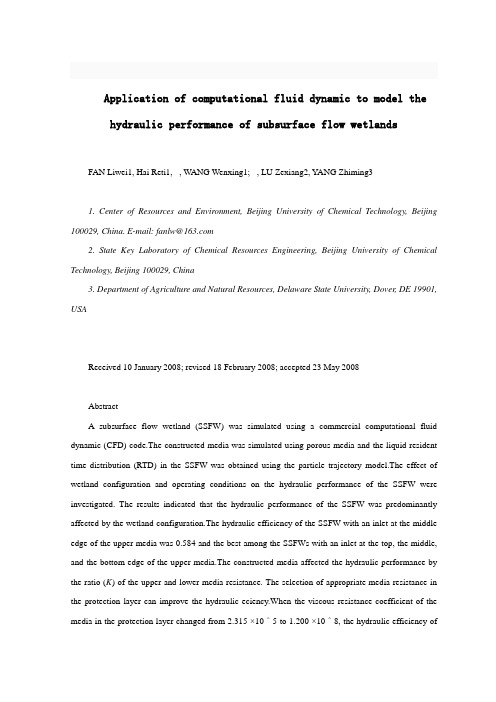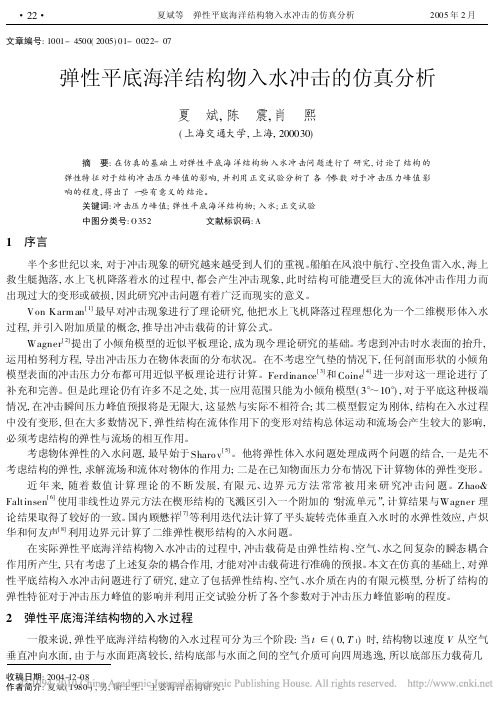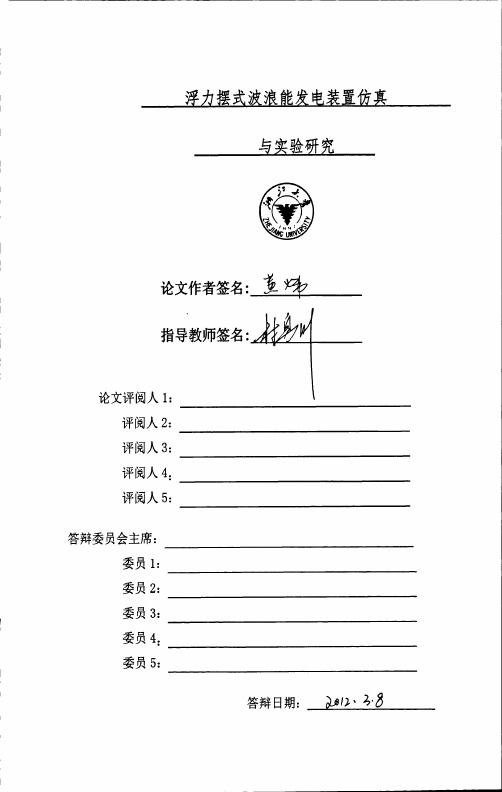Hydrodynamic simulation of elliptic flow
- 格式:pdf
- 大小:102.64 KB
- 文档页数:4

Application of computational fluid dynamic to model thehydraulic performance of subsurface flow wetlands FAN Liwei1, Hai Reti1, , WANG Wenxing1; , LU Zexiang2, YANG Zhiming31. Center of Resources and Environment, Beijing University of Chemical Technology, Beijing 100029, China. E-mail: fanlw@2. State Key Laboratory of Chemical Resources Engineering, Beijing University of Chemical Technology, Beijing 100029, China3. Department of Agriculture and Natural Resources, Delaware State University, Dover, DE 19901, USAReceived 10 January 2008; revised 18 February 2008; accepted 23 May 2008AbstractA subsurface flow wetland (SSFW) was simulated using a commercial computational fluid dynamic (CFD) code.The constructed media was simulated using porous media and the liquid resident time distribution (RTD) in the SSFW was obtained using the particle trajectory model.The effect of wetland configuration and operating conditions on the hydraulic performance of the SSFW were investigated. The results indicated that the hydraulic performance of the SSFW was predominantly affected by the wetland configuration.The hydraulic efficiency of the SSFW with an inlet at the middle edge of the upper media was 0.584 and the best among the SSFWs with an inlet at the top, the middle, and the bottom edge of the upper media.The constructed media affected the hydraulic performance by the ratio (K) of the upper and lower media resistance. The selection of appropriate media resistance in the protection layer can improve the hydraulic eciency.When the viscous resistance coefficient of the media in the protection layer changed from 2.315 ×10^5 to 1.200 ×10^8, the hydraulic efficiency ofthe SSFW increased from 0.301 to 0.751. However, the effect of operating conditions on the hydraulic eciency of the SSFW was slight.Key words: subsurface flow wetland; computational fluid dynamic; resident time distribution; hydraulic performanceIntroductionThe wastewater treatment technology by subsurface flow wetland (SSFW) relies on the functions of media-microorganism-vegetable to achieve efficient removal of pollutants by a combination of physical, chemical, and biological processes. The processes of physical, chemical,and biological treatment in a wetland system depend on the flow of the water. Therefore, the hydraulic characteristics within the system have a significant effect on the efficiency of the wetland as a water treatment device (Hu, 1991;Feng and Molz, 1997; Chazarenc et al., 2003). Many wetland management problems can be attributed to poor hydrodynamic characteristics within the wetland system(Persson et al., 1999). An appropriate hydraulic design not only can improve the pollutant removal eciency but also can reduce the cost and achieve optimal benefits of treatment and engineering (Badkoubi et al., 1998; Garc´ıa et al., 2004a; Garc´ıa et al., 2005).Good engineering design demands a detailed understanding of the hydraulic characteristics within a system.Some studies have been devoted to evaluate the impact parameters of the hydrodynamic behavior of constructed wetlands,including the vegetation(Kadlec,1990;Jain and Harindra,1995;serra et al., 2004),flow parameters(Kadlec, 1994), wind (Kadlec and Knight, 1996),temperature(Torres et al., 1997), inlet and outlet location(Persson et al., 1999; Suliman et al., 2006), water depth(USEPA, 2000; Huang et al., 2005), aspect ratio, and medium (William et al., 1995; Garc´ıa et al., 2004b;W¨orman and Kronn¨as, 2005; Molle, 2006; Suliman et al.,2007). However, the hydraulics of the wetland in the above publications was studied by physical tracer experiment that is expensive, time-consuming, and even impossible to perform in the majority of practical cases. Hence, using mathematical models as design tools can contribute to a better understanding of the flow patterns in wetlands.Computational fluid dynamics (CFD) is a sophisticated design and analysis tool to simulate the flow of mass and momentum throughout a fluid continuum. It is an advantage method to study the hydraulics and reaction in a constructed wetland because it is low cost, can be used to analyze the fullflow field and can be scaled up.The technique allows a computational model to be used under many dierent design constraints and is effective in water treatment device design and optimization, such as wastewater oxidation ponds (Wood et al., 1995), sedimentation tanks (Zhou and MeCorquodale, 1994; Matko et al., 1996), industrial reservoir (Ta and Brignal, 1998), and aquaculture raceway (Huggins et al., 2005). However, the flow through the filter constructed in the SSFW is different from that in the above water treatment devices. To the authors’ knowledge, no one has provided a CFD model for SSFWs until today.In this article,the hydraulic characteristics of an SSFW with a layer pattern constructed filter were studied by the CFD model,and the effect of wetland configuration(the inlet location,constructed media,and protection layer)and operating conditions(the inlet elocity(u)and outlet pressure)on the hydraulic performance of the SSFW were discussed thoroughly.This work further investigation of the CFD simulation on the pollutant removal in SSFWs.The author;FAN Liwei1, Hai Reti1, , WANG Wenxing1; , LU Zexiang2, Y ANG Zhiming3 Nationality:ChinaSource:Journal of Environmental Science(English)2008 12th edition Page8应用计算流体动力学模型来模拟地下水流水力性能的湿地FAN Liwei1, Hai Reti1,, WANG Wenxing1;, LU Zexiang2, YANG Zhiming31.中国北京化工大学资源与环境中心 1000292.中国北京化工大学国家重点实验化学资源工程 1000293.美国特拉华州州立大学自然资源和农业部 199012008年1月得到10次修订,2008年2月18日收到,2008年5月23日接受文摘(SSFW)是一个地下水流湿地模拟使用商业计算流体动力学(CFD)的代码。

基于OrcaFlex 的海洋柔性管水动力分析章仲怡(中海油能源发展股份有限公司清洁能源分公司,天津300450)摘要:柔性管水动力分析的准确性与保守性直接影响着其疲劳性能计算。
文章针对一种非黏结性柔性管,通过OrcaFlex 对其进行整体水动力分析,得到载荷曲线;并通过波浪筛选提取典型波浪工况,将其施加到OrcaFlex 分析模型中,得到了柔性管各位置处的载荷响应;最后提取了柔性管的最大弯矩和拉伸力数据,为下一步疲劳性能计算提供了数据支持。
关键词:非黏结性柔性管;力学响应分析;OrcaFlex ;弯矩;轴向拉伸力中图分类号:P75文献标志码:Adoi :10.13352/j.issn.1001-8328.2024.01.013Abstract :The accuracy and conservatism of hydrodynamic analysis on flexible pipes directly affect their fa⁃tigue performance calculation.This paper focuses on an unbonded flexible pipe and conducts an overall hydrody⁃namic analysis by OrcaFlex to obtain the load curve.Additionally ,it extracts typical wave conditions via wave screening and applies the conditions to the OrcaFlex analysis model for obtaining the load response at various posi⁃tions of the flexible tube.Finally ,the extracted maximum bending moment and tensile force data of the flexible pipe can provide data support for following fatigue performance calculation.Key words :unbonded flexible pipe ;mechanical response analysis ;OrcaFlex ;bending moment ;axialtensile force作者简介:章仲怡(1991-),男,天津人,工程师,大学本科,主要从事船舶与海洋工程结构物安装设计工作。

海底滑坡对置于海床表面管线作用力的CFD模拟王忠涛;王寒阳;张宇【摘要】海底管线是海洋工程中用于传输原油和天然气等的重要通道,通常放置在海床表面或处于悬跨状态.本文采用计算流体动力学CFD法模拟了不同冲击角度下海底滑坡对置于海床表面的海底管线的作用,得到了管线所受的轴向荷载和法向荷载与滑坡冲击角度之间的关系.同时分析了沿冲击方向管线截面形状与管线所受阻力之间的关系.对已有研究进行拓展延伸,丰富了不同工况下轴向阻力系数和法向阻力系数的计算成果,得出了海底滑坡对置于海床表面管线冲击力的计算公式.【期刊名称】《海洋学报(中文版)》【年(卷),期】2016(038)009【总页数】8页(P110-117)【关键词】海底滑坡;海底管线;CFD模拟;非牛顿流体;冲击截面形状【作者】王忠涛;王寒阳;张宇【作者单位】大连理工大学海岸和近海工程国家重点实验室,辽宁大连116024;大连理工大学岩土工程研究所,辽宁大连116024;大连理工大学海岸和近海工程国家重点实验室,辽宁大连116024;大连理工大学岩土工程研究所,辽宁大连116024;大连理工大学海岸和近海工程国家重点实验室,辽宁大连116024;大连理工大学岩土工程研究所,辽宁大连116024【正文语种】中文【中图分类】P642.22海洋中蕴藏着丰富的矿产资源,已成为资源开发较为活跃的区域。
由于承受着各种地质环境条件的制约,因而海底通常处于不稳定状态[1]。
而海底滑坡则是海底中最常见、出现频率最高的地质灾害[2]。
海底管线作为海上运输资源的主要手段,其数量也随着开发活动的愈加频繁而日益增加[3]。
海底滑坡能破坏海底石油平台与海洋工程设施,甚至能够引起诸如海啸等自然灾害,给经济社会造成重大损失[4]。
因此,评价海底的稳定性并进行滑坡-管线相互作用分析,不仅对资源开发防避相关地质灾害具有重要的科学意义和应用价值,而且可为深水区油气勘探平台的稳定性分析和天然气水合物勘探开发提供重要的科学依据[5]。

网络首发地址:https:///kcms/detail/42.1755.TJ.20230306.1820.004.html期刊网址:引用格式:刘亢, 曹留帅, 万德成. 基于主动射流方法的椭圆水翼梢涡空化抑制研究[J]. 中国舰船研究, 2023, 18(4):175–185.LIU K, CAO L S, WAN D C. Suppression of tip vortex cavitation of elliptical hydrofoil based on active water injection methods[J]. Chinese Journal of Ship Research, 2023, 18(4): 175–185.基于主动射流方法的椭圆水翼梢涡空化抑制研究扫码阅读全文刘亢1,2,曹留帅1,2,万德成*1,21 上海交通大学 船海计算水动力学研究中心,上海 2002402 上海交通大学 船舶海洋与建筑工程学院,上海 200240摘 要:[目的]梢涡空化会产生压力波动和流动噪声,预测梢涡空化的初生和发展过程,了解其作用机理并加以抑制是船舶螺旋桨与旋转机械亟待解决的问题。
[方法]以剖面为NACA 0012翼型的椭圆水翼为研究对象,基于IDDES 湍流模型和Schnerr-Sauer 空化模型,分别在全湿流和空泡流两种工况下对水翼梢涡及其空化现象进行模拟,分析水翼梢涡及其空化之间的相互作用特性。
进一步,通过主动射流方法控制水翼梢涡空化,并对比两种开孔射流方式,即垂向射流和侧向射流的作用效果。
[结果]以梢涡体积作为空泡抑制的判断标准,与无射流工况对比,垂向射流工况对空泡的抑制效果可达到8.09%;而在侧向射流工况下,射流对空泡的抑制效果更加明显,达到了10.47%。
结果证明两种主动射流方式均可以有效抑制梢涡空化。
[结论]通过机理分析发现,垂向射流会影响水翼梢涡入射流的流速及流向,提高梢涡湍动能的耗散项,从而降低水翼的梢涡强度;而在侧向射流工况下,射流则直接作用于梢涡,所携带的能量极大地破坏了水翼的梢涡结构,从而大大降低了梢涡空化现象的产生。

文章编号:1001-4500(2005)01-0022-07弹性平底海洋结构物入水冲击的仿真分析夏 斌,陈 震,肖 熙(上海交通大学,上海,200030) 摘 要:在仿真的基础上对弹性平底海洋结构物入水冲击问题进行了研究,讨论了结构的弹性特征对于结构冲击压力峰值的影响,并利用正交试验分析了各个参数对于冲击压力峰值影响的程度,得出了一些有意义的结论。
关键词:冲击压力峰值;弹性平底海洋结构物;入水;正交试验 中图分类号:O352 文献标识码:A1 序言 半个多世纪以来,对于冲击现象的研究越来越受到人们的重视。
船舶在风浪中航行、空投鱼雷入水,海上救生艇抛落,水上飞机降落着水的过程中,都会产生冲击现象,此时结构可能遭受巨大的流体冲击作用力而出现过大的变形或破损,因此研究冲击问题有着广泛而现实的意义。
Von Karm an[1]最早对冲击现象进行了理论研究,他把水上飞机降落过程理想化为一个二维楔形体入水过程,并引入附加质量的概念,推导出冲击载荷的计算公式。
Wagner[2]提出了小倾角模型的近似平板理论,成为现今理论研究的基础。
考虑到冲击时水表面的抬升,运用柏努利方程,导出冲击压力在物体表面的分布状况。
在不考虑空气垫的情况下,任何剖面形状的小倾角模型表面的冲击压力分布都可用近似平板理论进行计算。
Ferdinance[3]和Coine[4]进一步对这一理论进行了补充和完善。
但是此理论仍有许多不足之处,其一应用范围只能为小倾角模型(3°~10°),对于平底这种极端情况,在冲击瞬间压力峰值预报将是无限大,这显然与实际不相符合;其二模型假定为刚体,结构在入水过程中没有变形,但在大多数情况下,弹性结构在流体作用下的变形对结构总体运动和流场会产生较大的影响,必须考虑结构的弹性与流场的相互作用。
考虑物体弹性的入水问题,最早始于Sharo v[5]。
他将弹性体入水问题处理成两个问题的结合,一是先不考虑结构的弹性,求解流场和流体对物体的作用力;二是在已知物面压力分布情况下计算物体的弹性变形。

超大型浮体非线性水弹性原理及研究方法于文琪河海大学交通学院海洋学院,南京(210098)E-mail: ziye7777@摘要:近年来,超大型浮体的水弹性分析和二阶波浪力的理论研究已经较为成熟,但是大多数非线性水弹性研究并未应用二阶波浪力及高阶波浪力,一般只是计算一阶速度势对二阶波浪力的贡献,而忽略二阶及高阶项的计算。
本文对超大型浮体水弹性力学理论及与二阶和高阶波浪相关的分析方法的国内外情况作了介绍,并对今后需要开展的研究工作的方向提出了自己的看法。
关键词:超大型浮体,非线性,水弹性响应中国分类号:U661.11. 引言水弹性力学将浮体结构力学和浮体水动力学有机地结合起来,为评估柔性浮体结构的总体性能提供了一个更具一致性和合理性的方法。
水弹性理论至今已发展了20多年,着重研究线性问题。
而超大型浮体的尺度远大于入射波波幅,所以超大型浮体的水弹性问题一般被考虑为线性问题。
但是浮体运动时所引起的二阶力及瞬时湿表面变化引起的二阶流体力可能对浮体产生较大的非线性影响,所以就有必要研究二阶及高阶波浪力对超大型浮体水弹性响应的影响,为实际分析提供理论依据。
2. 超大型浮体水弹性分析原理及相关研究2.1 水弹性分析原理浮体在波浪中运动,不但会产生刚体六个自由度运动,而且会产生振动和弹性变形。
浮体在波浪中振动,大致分为两种:一种是由简谐波浪干扰力作用引起的稳态强迫振动,称为波激振动;另一种是波浪冲击力作用,引起浮体瞬态强迫振动,称为砰击振动,有时也称为冲荡。
一般情况下,浮体是假设为刚体,忽略其弹性变形,用‘切片理论’求得结构在波浪中的运动和受力厚,再由材料力学方法,得到结构的弯矩和剪力。
但是当浮体的尺度增大时,比如超大型浮体,它是一个极为扁平的柔性结构物,在计算中就不能假设为刚体,而应作为弹性体,用水弹性理论进行分析。
水弹性的概念最早是在二十世纪五十年代末期从空气弹性学中引进的,当时的定义是,水弹性是考虑到惯性力、水动力和弹性力之间相互影响的一种现象。
洋流影响下的水下滑翔机动力学建模、运动分析与控制器设计研究一、本文概述Overview of this article随着海洋科技的飞速发展,水下滑翔机作为一种新型的海洋探测设备,其在海洋环境监测、海底资源勘探、海洋灾害预警等领域的应用日益广泛。
然而,水下滑翔机在复杂的海洋环境中运行时,受到洋流、海流、潮汐等多种因素的影响,其动力学特性极为复杂。
因此,深入研究洋流影响下的水下滑翔机动力学建模、运动分析以及控制器设计,对于提高水下滑翔机的运行效率、稳定性和安全性具有重要意义。
With the rapid development of marine technology, underwater gliders, as a new type of marine exploration equipment, are increasingly widely used in fields such as marine environmental monitoring, seabed resource exploration, and marine disaster warning. However, when underwater gliders operate in complex marine environments, they are influenced by various factors such as ocean currents, ocean currents, tides,etc., and their dynamic characteristics are extremely complex. Therefore, in-depth research on the dynamics modeling, motion analysis, and controller design of underwater gliding under the influence of ocean currents is of great significance for improving the operational efficiency, stability, and safety of underwater gliders.本文旨在探讨洋流影响下的水下滑翔机动力学建模方法,分析水下滑翔机在洋流作用下的运动特性,研究控制器设计策略以提高水下滑翔机的运动性能和鲁棒性。
Advances in Environmental Protection 环境保护前沿, 2020, 10(4), 510-515Published Online August 2020 in Hans. /journal/aephttps:///10.12677/aep.2020.104061Research Progress on Applicationof MIKE21 Hydrodynamic ModelQing Luo, Lihong Liu, Yumeng WangDepartment of Earth and Environment, Anhui University of Science & Technology, Huainan AnhuiReceived: Jul. 15th, 2020; accepted: Aug. 4th, 2020; published: Aug. 11th, 2020AbstractMIKE21 model is a reliable means and an important basis for studying the movement of surface water flow. The model simulation of planar two-dimensional water flow is of great significance for the actual water condition verification, hydrological change calculation and future trend predic-tion. At present, many experts and scholars have carried out practical application of multi-angle, multi-level and different fields, and have repeatedly verified the accuracy and fit of the MIKE21 model. This paper mainly reviews the application of MIKE21 hydrodynamic model in river flood analysis, flood evolution in flood storage area, analysis of urban waterlogging risk and impact of water conservancy construction. The hydrological changes, general conclusions and application limitations, which are obtained, are discussed by the model under different simulation conditions.On this basis, it elaborates and summarizes, and forecasts the application and development trend of MIKE21 hydrodynamic model.KeywordsMIKE21 Hydrodynamic Model, River Flood, Flood Evolution in Flood Storage Area, UrbanWaterlogging, Water Conservancy ConstructionMIKE21水动力学模型应用研究进展罗庆,刘丽红,王雨蒙安徽理工大学地球与环境学院,安徽淮南收稿日期:2020年7月15日;录用日期:2020年8月4日;发布日期:2020年8月11日摘要MIKE21水动力学模型是研究地表水流运动的可靠手段和重要依据,模型关于平面二维水流的模拟,对罗庆等于实际水情验证、水文变化计算、未来趋势预测具有重要意义。
a rXiv:n ucl-t h /99725v17J ul19991Hydrodynamic simulation of elliptic flow ∗P.F.Kolb a,b ,J.Sollfrank b ,P.V.Ruuskanen c ,and U.Heinz a a CERN/TH,CH-1211Geneva 23b Institut f¨u r Theoretische Physik,Universit¨a t Regensburg,D-93040Regensburg c Department of Physics,University of Jyv¨a skyl¨a ,FIN-40351Jyv¨a skyl¨a We use a hydrodynamic model to study the space-time evolution transverse to the beam direction in ultrarelativistic heavy-ion collisions with nonzero impact parameters.We focus on the influence of early pressure on the development of radial and elliptic flow.We show that at high energies elliptic flow is generated only during the initial stages of the expansion while radial flow continues to grow until freeze-out.Quantitative compar-isons with SPS data from semiperipheral Pb+Pb collisions suggest the applicability of hydrodynamical concepts already ≈1fm/c after impact.1.Hydrodynamic model with longitudinal boost invariance The transverse expansion dynamics in non-central heavy-ion collisions at SPS energies has recently attracted much attention [1–7].We here study it within the hydrodynamic model.In order to reduce the complexity of the numerical task we follow [4]and implement analytically Bjorken scaling flow with v z =z/t in the longitudinal direction and onlysolve the transverse dynamics numerically.The Bjorken ansatz holds exactly at infinite beam energy,but properly restricted to a finite rapidity interval it is phenomenologically successful also at SPS and AGS energies [8].It breaks down,however,near target and projectile rapidities;using it we can therefore reliably compute the transverse expansion only near midrapidity.The system of hydrodynamic equations is closed by an equation of state (EOS)p (e,n )giving the pressure as a function of energy and baryon density.Hydrodynamics thus provides a direct relation between the EOS and the dynamical evolution of the system.To study the dynamical effects of a softening of the EOS in the neighborhood of a phase transition to quark-gluon plasma we use three different equations of state.EOS I is the hard equation of an ideal ultrarelativistic gas,p =e/3.EOS H is the much softer EOS for a gas of interacting hadron resonances;for n ≈0it satisfies p ≈0.15e .A Maxwell construction between these two EOS,adding a bag pressure B 1/4=230MeV,results in EOS Q which has a phase transition at T cr (n =0)=164MeV with a latent heat of 1.15GeV/fm 3[9].The system is frozen out at a fixed decoupling temperature T dec ,and all unstable resonances are allowed to decay before we compare with experimental data.22.Space time evolution of the reaction zoneWe initialize the reaction zone with transverse energy and baryon density profiles which are taken to be proportional to the transverse density of wounded nucleons calculated from the Glauber model [4,10].The initial configuration is thus parametrized by theenergy and baryon densities e 0and n 0in central Figure 1.Time evolution of thespatial eccentricity ǫx (top),themomentum anisotropy ǫp (middle),and the radial flow v ⊥ (bottom).collisions.For each EOS these parameters and the decoupling temperature are fixed by a fit [10]to the negative hadron and net proton m t -spectra at midrapidity from central Pb +Pb collisions at 158A GeV [11].The spectra for non-central collisions are then predicted without extra parameters.The hydrodynamic evolution provides the time-dependence of the matter in coordinate and mo-mentum space.In non-central collisions,the ini-tial spatial deformation of the reaction zone in the transverse plane,characterized by its spatial eccentricity ǫx = y 2−x 2T xx +T yy.At freeze-out this hydrodynamic quantity is directly related to the elliptic flow v 2= cos(2ϕ) ,defined by an average over the final particle momentum spectrum;for pions ǫp ≈2v 2[7].In contrast to v 2,ǫp can be studied as a function of time and gives access to the buildup of elliptic flow.The developing stronger flow into the collision plane leads to a decrease of ǫx with time;the buildup of elliptic flow thus slows down and even-tually shuts itself off.This is clearly seen in the upper two panels of Fig.1:ǫp saturates when ǫx passes through zero.For a hard EOS this happens faster than for a soft one;also,the total amount of elliptic flow which can be generated by a given EOS increases with its hardness c 2s =∂e3 For EOS I the system freezes out before the ellipticflow is fully developed;for EOS H and EOS Q the opposite is true.The radialflow,characterized by v⊥ = γ4our hydrodynamical results at midrapidity,obtained with EOS Q and initial conditions tuned to central collisions as described above.The WA98data extend to very peripheral collisions:the lowest spectrum in Fig.2corresponds to b=13fm where hydrodynamics certainly looses its applicability.At such large impact parameters one does not observe the collision of two nuclei,but rather two dilute nucleon clouds penetrating each other. At smaller impact parameters the model fails in the high-m t region;here hard scattering processes begin to dominate which cannot be modeled hydrodynamically.Up to b≈10 fm(bin6represents impact parameters up to11fm[2])and transverse masses of about2 GeV,however,hydrodynamics works very well,both for the pion and net proton spectra. (For the latter the CERES data in Fig.3do not extend to very peripheral collisions,the largest measured impact parameters corresponding to about8.4fm[3].)4.SummaryWe have demonstrated the interplay between spatial eccentricity as the driving force for generating momentum space asymmetries and the back-reaction of the latter on the parison with measured spectra from Pb+Pb collisions with varying impact parameter showed that the hydrodynamical model successfully reproduces the data up to b=8-10fm.The good quantitative agreement between data and model suggests rather rapid thermalization in the reaction zone.Iffinal data confirm that the ellipticflow is essentially saturated in Pb+Pb collisions at the SPS,this would provide strong evidence for very early pressure in the system.In our calculations a large fraction of thefinally ob-served ellipticflow is generated while the energy density exceeds the critical value e cr=1 GeV/fm3for deconfinement.This confirms the suggestion[5]that ellipticflow is a probe for the early collision stage.We thank Th.Peitzmann(WA98)and F.Ceretto(CERES)for sending us their pre-liminary data prior to publication.P.K.wishes to express his gratitude to the CERN Summer Student Programme and thanks T.Peeter’s group for their warm hospitality. REFERENCES1.H.Appelsh¨a user et al.(NA49Coll.),Phys.Rev.Lett.80(1998)41362. C.Blume,PhD thesis,Universit¨a t M¨u nster,1998;M.M.Aggarwal et al.(WA98Col-laboration),Phys.Rev.Lett81(1998)40873. F.Ceretto,PhD Thesis,Universit¨a t Heidelberg,1998;P.Braun-Munzinger,J.Stachel,Nucl.Phys.A638(1998)3c4.J.Y.Ollitrault,Phys.Rev.D46(1992)2295.H.Sorge,Phys.Lett.B402(1997)251;Phys.Rev.Lett.82(1999)20486. D.Teaney,E.Shuryak,nucl-th/99040067.P.F.Kolb,J.Sollfrank,U.Heinz,nucl-th/9906003,Phys.Lett.B,in press8.H.Dobler,J.Sollfrank,U.Heinz,nucl-th/9904018,Phys.Lett.B,in press9.J.Sollfrank et al.,Phys.Rev.C55(1997)39210.P.F.Kolb,Diploma Thesis,Universit¨a t Regensburg,1999;P.F.Kolb,J.Sollfrank,U.Heinz,in preparation11.H.Appelsh¨a user et al.(NA49Coll.),Phys.Rev.Lett.82(1999)2471。